
This is a directory of properties and districts listed on the National Register of Historic Places in Arizona. There are about fourteen hundred listed sites in the state, and each of its fifteen counties has at least ten listings on the National Register. Forty-five of the state's sites are further designated as National Historic Landmarks.

Yuma Crossing is a site in Arizona and California that is significant for its association with transportation and communication across the Colorado River. It connected New Spain and Las Californias in the Spanish Colonial period in and also during the Western expansion of the United States. Features of the Arizona side include the Yuma Quartermaster Depot and Yuma Territorial Prison. Features on the California Side include Fort Yuma, which protected the area from 1850 to 1885.
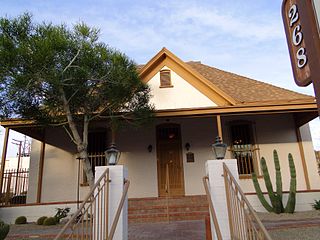
The Brown House is a 19th-century house in Yuma, Arizona, built of brick in the 1890s.

Yuma Quartermaster Depot State Historic Park, formerly Yuma Crossing State Historic Park, and now one of the Yuma Crossing and Associated Sites on the National Register of Historic Places in the Yuma Crossing National Heritage Area. It is an Arizona state park in the city of Yuma, Arizona, USA.

Ortiz House in Yuma, Arizona was built in 1901. It was listed on the National Register of Historic Places in 1982.

The Southern Pacific Railroad Depot in Yuma, Arizona, was built as a Spanish Colonial Revival-style station by the Southern Pacific Railroad in 1926.
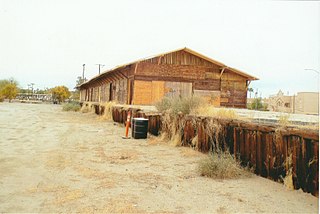
Southern Pacific Freight Depot in Yuma, Arizona was built in 1891, built with redwood shiplap and in the wooden Stick—Eastlake architectural motifs of the Victorian Queen Anne Style.
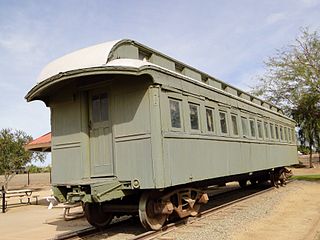
Southern Pacific Railroad Passenger Coach Car-S.P. X7 dates from c. 1875 and was used until 1938. It is a former passenger coach of the Southern Pacific Railroad's Southern Division. The railway vehicle was listed on the National Register of Historic Places in 2000, at which time it was located in Yuma, Arizona.

The Masonic Temple in Yuma, Arizona was built in 1931 in the late Art Deco style of Moderne. It was designed by Los Angeles-based architects Edward Gray Taylor and Ellis Wing Taylor. In 1933, at the depth of the Great Depression, the Masonic lodge lost all its funds in a bank closure. On November 16, 1933, the building's ownership was turned over to the Pacific Mutual Life Insurance Company "in satisfaction of a $16,900 realty mortgage." It was later rented back to the Masonic chapter and on May 10, 1940, ownership was restored.
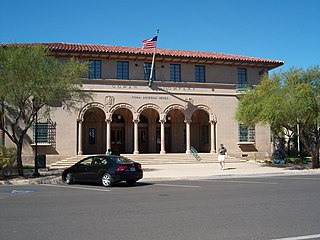
The U.S. Post Office—Yuma Main, also known as Yuma Main Post Office or Yuma Downtown Postal Annex, is the former main post office serving Yuma, Arizona. The post office was constructed in 1933. The building's design, a work of architect Roy Place, is a blend of the Beaux Arts and Spanish Colonial Revival styles. The design includes a loggia supported by Corinthian columns, wrought iron railings and window bars, a molded belt course between the building's two stories, a projecting bracketed cornice, and a red tile roof. The post office was built toward the end of the Beaux-Arts phase of federal building design, as government architects shifted to a "starved classicism" style in the ensuing years.
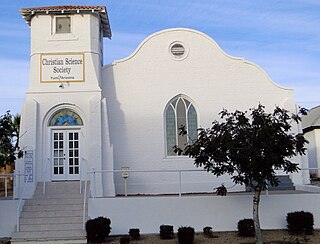
The Methodist Episcopal Church is a historic Methodist church, located at 256 S. 1st Avenue in Yuma, Arizona. It has been home to the Christian Science Society-Yuma since 1946.
Norman Foote Marsh (1871-1955) was an American architect based in Los Angeles, California who worked mostly in California and Arizona.
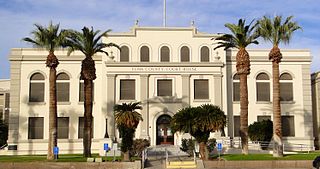
The Yuma County Courthouse is a historic building in Yuma, Arizona. It is the third building to serve as the courthouse of Yuma County, Arizona. It was built in 1928, and designed by Ralph Swearingen & G. A. Hanssen, two architects from San Diego, California. It has been listed on the National Register of Historic Places since December 7, 1982.

The Mexican Consulate is a historic adobe house in Yuma, Arizona. It was built circa 1892 for Dionicio Sanchez and his wife, Mary. In 1897, it was purchased by John Stoffela, who rented it to Henry M. Gandolfo, the Mexican consul, in the 1900s. The house houses the Mexican consulate in Yuma while Gandolfo resided here. It remained in the Stoffela family until 1978. It has been listed on the National Register of Historic Places since December 7, 1982.

The J. Homer Smith is a historic house in Yuma, Arizona. It was built in 1917 for J. Homer Smith, a druggist and banker who served as the mayor of Yuma. He later moved to Tucson, and he died in 1936. The house was designed in the American Craftsman architectural style. It has been listed on the National Register of Historic Places since December 7, 1982.

The Ruth Ewing House is a historic concrete block cottage in Yuma, Arizona, with a hipped roof. It was built in 1906 for Ruth Ewing, a parishioner of the St. Paul's Episcopal Church. Ewing bequeathed the house to the church, and it was later purchased by Reverend R. W. Dixon. It has been listed on the National Register of Historic Places since December 7, 1982.

The Balsz House is a historic adobe house in Yuma, Arizona. It was built in 1899 by Harry Neahr, and it belonged to the Balsz family from 1919 to 1976. The Balszes worked in the meat industry. The house is "a well preserved example of middle class housing in Yuma at the turn of the century." It has been listed on the National Register of Historic Places since December 7, 1982.

The Brownstetter House is a historic house in Yuma, Arizona. It was built in 1909. From 1912 to 1949, it belonged to Harry Brownstetter, "a successful merchant, real estate developer, and financier." The house was designed in the American Craftsman and the Victorian architectural styles.

The Jerry Kent House is a historic house in Yuma, Arizona. It was built in 1905 for Jennie Kent, a schoolteacher. It was purchased by J. P. Yemen, a dentist, in 1920. The house was designed in the Classical Revival architectural style. It has been listed on the National Register of Historic Places since December 7, 1982.


















